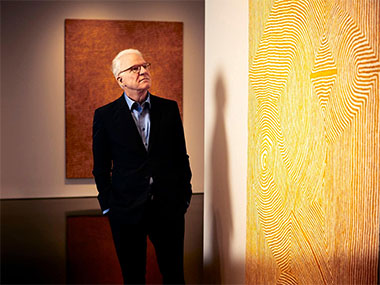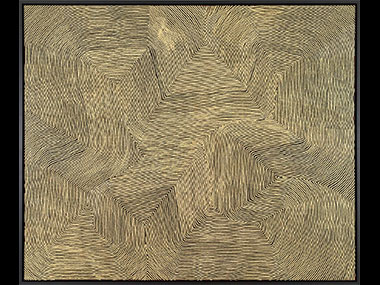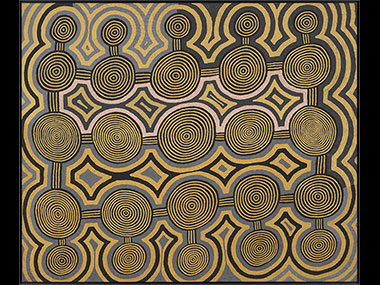The Gagosian Effect

Collector, writer and actor, Steve Martin with his Aboriginal art collection at Gagosian Gallery in New York
Posted by Jeremy Eccles | 20.05.19
Location: Gagosian Gallery, 976 Madison Avenue, New York
As I predicted, the arrival of a significant Aboriginal art collection at one of the world's most prestigious art dealers – Gagosian in New York – accompanied by the name of a famous collector (and inimitable comic) Steve Martin is having a ripple effect. Both the NY Times and the Washington Post are regaling their readers with the news – and adding the sort of analysis that all-too-rarely accompanies commentary on Indigenous art and culture in its homeland, Australia.
Jason Farago in the NY Times is not a name I've encountered before – but his thoughts deserve wide circulation wherever Aboriginal art can be found:
“The artists at Gagosian are their (the pioneers of Papunya) successors, and take a different tack. Highly aware that these paintings circulate in white-dominated spaces, they do not depict ritual knowledge with legible forms, but rather layer, abbreviate, distend and obfuscate these forms into patterns that are neither properly “abstract” nor exactly representational.
Mr. (Warlimpirrnga) Tjapaltjarri draws on handed-down knowledge of the geographical, cultural and mystical features of his country, which exist in a timeless realm known as the Dreamtime (or “Tjukurrpa,” in Pintupi). His painting at Gagosian probably maps a salt lake in the desert and draws on a Dreamtime story of its creation. Yet he does not offer all that knowledge on canvas; it remains guarded, taught only to initiates. His decision to share it with the art world, to win both cultural respect and financial reward, comes with a related insistence on holding something back — what the (late) Caribbean philosopher Édouard Glissant called a “right to opacity” (in his book 'Philosophie de la Relation' 2009).
Quite like the poker-faced art of Jasper Johns, these beautiful but reticent paintings take on cultural forms that change meaning and context as they circulate. Their different values — personal expressive value, shared cultural value and immediate financial value — jostle against one another, and each performs a balancing act between secrecy and disclosure.
To us, the shimmering ridges and switchbacks in the paintings of Mr. Tjapaltjarri or Ms. (Yukultji) Napangati suggest landscapes and histories, and our pleasure in them derives in part from their inscrutability. To a Pintupi viewer, they function like Homeric epithets — jogging the memory, reiterating sacred knowledge".
The mnemonics of Homer and the poker-face of Jasper Johns have surely never been connected to Aboriginal art before! But why not??
The Washington Post's Sebastian Smee is a much more familiar name to Australian readers – he used to write for 'The Australian' before heading Stateside and winning a Pulitzer Prize for criticism. As a result, perhaps, he felt less need to analyse, but took the opportunity to interview the well-informed star – Steve Martin:
“I think if you stuck one up at Sotheby’s in the contemporary art sale,” Martin says, “people would go, ‘Uh-huh, it makes total sense that it would be there.’ There’s nothing wrong with it being ethnographic. But I maintain that Aboriginal art can live in the Museum of Modern Art without a special designation. I love the idea that prior to 1970, there was sand, body painting and carving. And then this whole download onto board and canvas comes spontaneously. I mean it’s just like, wow!”
Part of what fascinates Martin about Aboriginal art is what he calls its “lack of irony.” Unlike a lot of contemporary art, he says, “there is no question of it being either safe or daring. The work is directly proportionate to the emotions of the artist.”
Martin is simply hoping good things come from the show. What he’d really love (and discussions are underway) is a focused, carefully selected museum show. “I’m sort of in favor of a small room in a great institution,” he says. “Because it’s so impactful in these small spaces. Without trying to tell the history, without being didactic, you can just go: ‘Pictures — look!’ ”
This exhibition has now moved to Gagosian, Beverley Hills until September 6th.
The ripples widen.
Meanwhile, on the other side of the US, the Global Artist Initiative based at the Vita Art Center in Ventura County, has picked on Australian Aboriginal artists for its 2019 iteration. Previously, activist artists from Cuba and Mexico, a woman street artist from Afghanistan and a dissident exile from North Korea have won the prize of a trip to Ventura, an exhibition of their paintings and the opportunity to contribute a work to the Ventura community.
This year, the Initiative starts with a national selection as part of Sydney's Pyrmont Festival – artists should enter images of five of their works, one of which will be chosen for a display of the finalists' work in September. In October the winner heads for the USA.
Closing date for entries is July 31st. Details of entry are below.
URL: https://www.vitaartcenter.com/australian-aboriginal-artist-entry-form
Share this:
»  del.icio.us
»
del.icio.us
»  Digg it
»
Digg it
»  reddit
»
reddit
»  Google
»
Google
»  StumbleUpon
»
StumbleUpon
»  Technorati
»
Technorati
»  Facebook
Facebook
Contact Details

The eye-popping Warlimpirrnga Tjapaltjarri canvas, 'Untitled' (2013) which first drew Steve Martin to Aboriginal art. Photography by Rob McKeever

Ronnie Tjampitjinpa 'Tarkulgna' (1988) Synthetic polymer paint on linen © Ronnie Tjampitjinpa, photography by Rob McKeever. Courtesy Gagosian
Further Research
Artists: Ronnie Tjampitjinpa | Warlimpirrnga Tjapaltjarri | Yukultji Napangati
News Tags: Gagosian Gallery | Global Artist Initiative | Jason Farago | Jeremy Eccles | Pyrmont Festival | Sebastian Smee | Steve Martin | Vita Art Center
News Categories: Art Prize | Blog | Event | Exhibition | Feature | Festival | Industry | News | North America
Exhibition Archive
- 02.08.19 | Blak Douglas Wins the Kilgour
- 31.07.19 | Save the Date - Tarnanthi in October
- 22.07.19 | The McKenzie Powerhouse
- 20.06.19 | Large Scale Digital Art Exhibition
- 06.06.19 | FAIRS FAIRS
- 05.06.19 | NY is the Epicentre
- 30.05.19 | Namatjira Wins the Ramsey
- 20.05.19 | The Gagosian Effect
- 13.05.19 | INTERESTING TIMES
- 03.05.19 | GAGOSIAN OPENING TONIGHT
- 02.05.19 | WHO'LL WIN THE WYNNE IN 2019?
- 01.05.19 | Telstra NATSIAA finalists announced
- 14.04.19 | Gagosian Goes Aboriginal
- 10.04.19 | An Indigenous Biennale?
- 30.03.19 | Kunmanara Williams Stars at The National
Advertising

